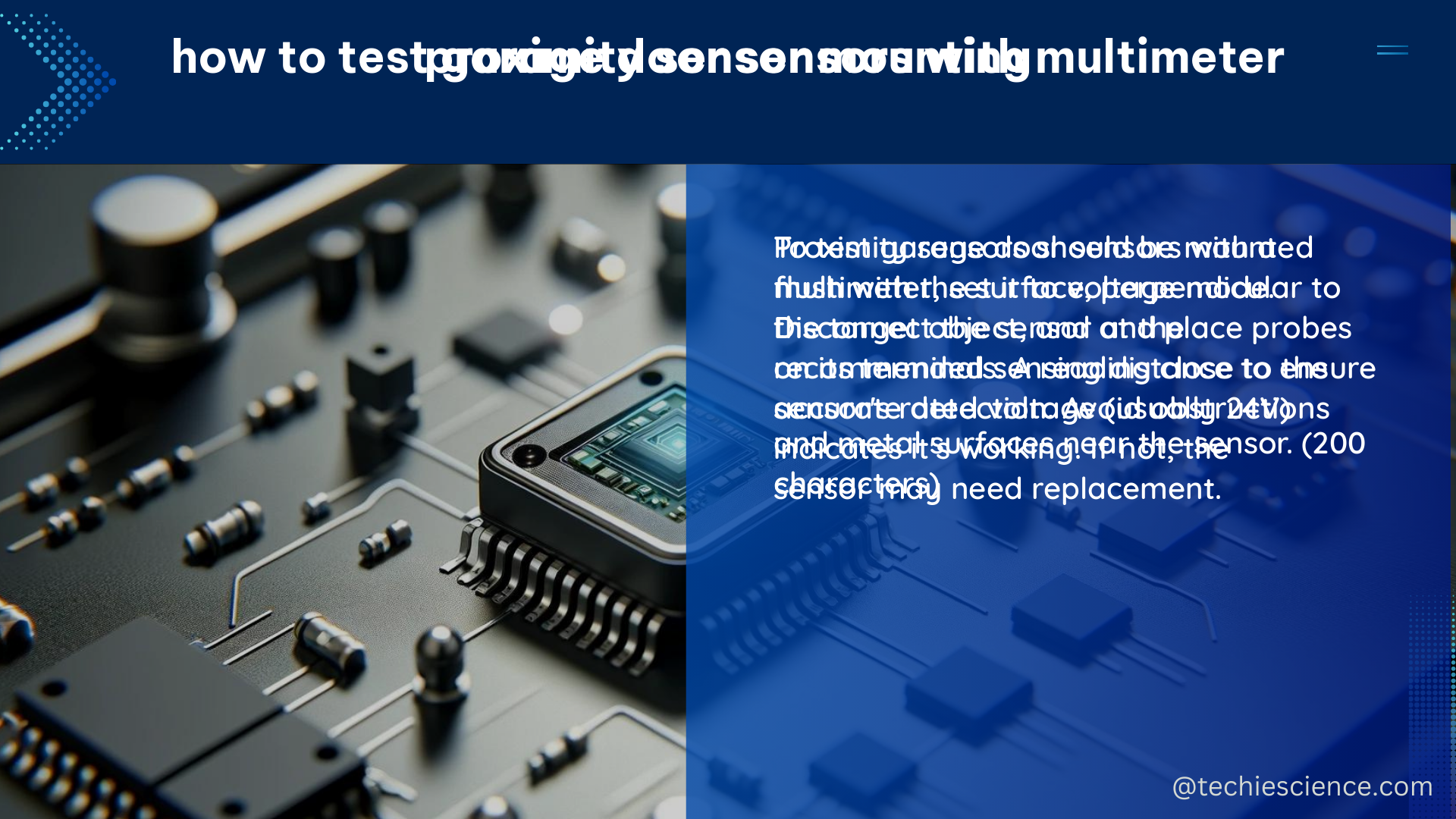Proximity sensor mounting is a critical aspect of ensuring accurate and reliable object detection in various industrial and technological applications. The positioning, orientation, and materials used can significantly impact the performance of proximity sensors. This comprehensive guide delves into the measurable and quantifiable factors that are essential for successful proximity sensor mounting.
Mounting Position and Orientation
The position and orientation of the proximity sensor can significantly influence its performance. Vertically mounted proximity sensors, such as the Saturn 2, can ensure maximum travel in any direction, while horizontally mounted sensors, like those used in the FLA kit machine and CNCRP kits, can provide better accuracy and repeatability. The target’s movement relative to the sensor face also plays a crucial role. Moving the target across the sensor face can result in better accuracy and repeatability compared to the target sliding past the sensor.
When mounting proximity sensors, consider the following guidelines:
- Vertical Mounting: Vertical mounting, as seen in the Saturn 2, allows for maximum travel in any direction, making it suitable for applications where the target’s movement is unpredictable or multidirectional.
- Horizontal Mounting: Horizontal mounting, as used in the FLA kit machine and CNCRP kits, can provide better accuracy and repeatability, especially when the target’s movement is linear and predictable.
- Target Movement: Ensure that the target moves across the sensor face rather than sliding past it, as this can improve accuracy and repeatability.
Reduction Factor

The reduction factor is a quantifiable measure that quantifies the impact of different metals on the performance of inductive sensors. Due to the varying conductivity of metals in the magnetic field, each sensor is provided with a reduction factor for each type of metal, which affects the sensor’s measuring range.
Table 1: Reduction Factors for Common Metals
| Metal | Reduction Factor |
|---|---|
| Aluminum | 1.0 |
| Brass | 0.4 |
| Copper | 0.4 |
| Stainless Steel | 0.2 |
| Mild Steel | 0.1 |
When selecting a proximity sensor and mounting it, it’s essential to consider the reduction factor of the target material to ensure accurate and reliable detection.
Sensing Range and Detection Distance
Proximity sensors have a specific sensing range and detection distance, which can be affected by the mounting position and orientation. For instance, the pick-up distance of inductive sensors is cut in half when using steel instead of aluminum.
Table 2: Sensing Range and Detection Distance for Inductive Proximity Sensors
| Target Material | Sensing Range | Detection Distance |
|---|---|---|
| Aluminum | 10 mm | 10 mm |
| Brass | 6 mm | 6 mm |
| Stainless Steel | 5 mm | 5 mm |
| Mild Steel | 3 mm | 3 mm |
When mounting proximity sensors, ensure that the target material and the sensor’s sensing range and detection distance are compatible to achieve optimal performance.
Environmental Influences
Environmental factors, such as temperature, humidity, and vibration, can significantly affect the performance of proximity sensors. It’s crucial to consider the sensor’s operating temperature range and ensure that it is suitable for the intended application environment.
Table 3: Operating Temperature Ranges for Proximity Sensors
| Sensor Type | Operating Temperature Range |
|---|---|
| Inductive | -25°C to +70°C |
| Capacitive | -25°C to +70°C |
| Photoelectric | -10°C to +55°C |
| Ultrasonic | -20°C to +70°C |
Proper mounting and shielding of proximity sensors can help mitigate the impact of environmental factors and ensure reliable performance.
Noise Measures
Noise measures are crucial in ensuring the accurate performance of proximity sensors. The noise measures method includes identifying the noise source, measuring the noise level, and implementing measures to reduce noise interference.
When mounting proximity sensors, consider the following noise reduction techniques:
- Shielding: Use metal shielding around the sensor and its wiring to reduce electromagnetic interference (EMI) and radio frequency interference (RFI).
- Grounding: Ensure proper grounding of the sensor and its associated components to minimize noise interference.
- Filtering: Implement appropriate filtering techniques, such as low-pass filters, to remove high-frequency noise from the sensor’s output signal.
- Sensor Placement: Position the proximity sensor away from potential noise sources, such as motors, power lines, and other electrical equipment.
By following these noise reduction measures, you can ensure the accurate and reliable performance of your proximity sensors.
Conclusion
Proximity sensor mounting is a complex and critical aspect of ensuring accurate and reliable object detection in various applications. By understanding the measurable and quantifiable factors, such as mounting position and orientation, reduction factor, sensing range and detection distance, environmental influences, and noise measures, you can optimize the performance of your proximity sensors and achieve the desired results.
Remember to always refer to the manufacturer’s recommendations and guidelines when mounting proximity sensors, as they may have specific requirements or best practices for their products. With the right approach and attention to detail, you can successfully integrate proximity sensors into your system and enjoy reliable and accurate object detection.
References:
– Omron FAQ on Proximity Sensor Mounting
– Disruptive Technologies Guide on Installing Proximity Sensors
– Science.gov Proximity Sensor System
– CNCZone Forum on Proximity Sensor Mounting
– Festo Inductive Proximity Switches

The lambdageeks.com Core SME Team is a group of experienced subject matter experts from diverse scientific and technical fields including Physics, Chemistry, Technology,Electronics & Electrical Engineering, Automotive, Mechanical Engineering. Our team collaborates to create high-quality, well-researched articles on a wide range of science and technology topics for the lambdageeks.com website.
All Our Senior SME are having more than 7 Years of experience in the respective fields . They are either Working Industry Professionals or assocaited With different Universities. Refer Our Authors Page to get to know About our Core SMEs.